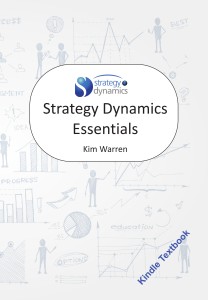Kim Warren on Strategy
Strategy insights and living business models
Strategy Dynamics Briefing 39: Resources carry attributes from stage to stage
Earlier briefings [starting at no.24] explained how resources carry attributes with them when won by, or lost from an organization. Resources also carry attributes with them as they develop from stage to stage.
Which common case illustrates this?
Good Strategy: Bad Strategy. Rumelt
I look forward to any new strategy book, so was thrilled to get “Good Strategy: Bad Strategy” by Prof Rumelt who McKinsey call ”strategy”s strategist”. Big disappointment! “Bad…
Strategy Dynamics Briefing 38: When Resources Deteriorate
Not all resources ‘develop’ in a positive direction. Equipment and other fixed assets deteriorate, often through recognizable stages. Management of physical assets is a neglected issue in strategy, even in operations management. Read on to find out more…
Strategy Masters
Great to see serious Strategy courses on offer, rather than superficial MBAs. The Vienna University Masters in Strategy, Innovation and Management Control is a recent case that will…
Another dot-com bubble?
Back in 1999 I got booed for saying the dot-com boom was mostly hot air, after which the NASDAQ dropped from 1000 to 200. The Economist now warns…
Strategy Dynamics Briefing 37: Product development
Briefing 36 introduced the idea that resources develop through stages. Product development is one such process that has long been well understood.
What are the yypical stages?
MIT on Intelligent Enterprise
Analytics: the New path to Value reports on what leading firms are doing with analytics. It offers five big recommendations. Whilst reasonable enough, they raise more questions than…
Strategy Dynamics Briefing 36: Developing resources
So far, we have simply assumed that resources can be switched on and off, but in many cases, resources may develop through a series of states. Sometimes this happens entirely within an organization, such as products being moved through stages in the R&D process. For some items, though, development may extend outside the organization, such as the growing awareness and interest of potential customers, and the continued influence of former customers.
How does this influence strategic thinking?
Strategy Dynamics Briefing 35: Undermining a competitor
Appraising competitors often involves assessing their strengths and weaknesses in some way, comparable to parts of the SWOT approach that management might use to assess their own business. But such approaches are qualitative and high-level, and quite inadequate for designing and implementing specific competitive campaigns. A more rigorous approach …
Strategy Dynamics Briefing 34: Truly competitive strategy
Strategy very often includes a need to beat competitors as well as running our own business well, and we have long understood how competitive forces affect industry profitability. Those forces include not just existing direct competitors, but customers’ buying power, suppliers’ control of key inputs, and pressure from substitute products and new competitors. Firms can and do try to manipulate those forces to support stronger profits, for example by getting their customers locked-in to buying from them in some way.
But you can go further…

